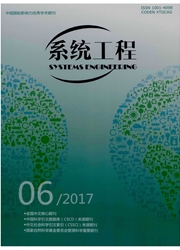

 中文摘要:
中文摘要:
South-to-North 水转向(SNWD ) 工程是想在诺思中国解决水缺乏问题的一个重要工程工程。面对了水转向系统的市场操作管理,这研究定义供应链系统因为考虑到实际工程调节, SNWD 工程用漂浮的定价机制( FPM )与战略顾客行为( SCB )造了一个分散的决定模型和一个集中的决定模型,并且经由一个分享收入的合同构造了协作机制。结果建议下列:( 1 )由于水缺乏补充和过量水出售,政策由 FPM 提供了,水资源的最佳的订数量是不到那没有 FPM ,和整个供应链的最佳的利润,供应商,并且外部分发者比他们将没有 FPM 的高级;(2 ) 没有 SCB,有 SCB 的批发定价和增补批发定价比那些高,并且全部的最佳的利润供应链,供应商,和外部分发者比他们将没有 SCB 的高;并且(3 ) 考虑 SCB 并且介绍 FPM 帮助增加全部的最佳的利润供应链,供应商,和外部分发者,并且改进水资源用法的效率。
 英文摘要:
英文摘要:
The South-to-North Water Diversion (SNWD) Project is a significant engineering project meant to solve water shortage problems in North China. Faced with market operations management of the water diversion system, this study defined the supply chain system for the SNWD Project, considering the actual project conditions, built a decentralized decision model and a centralized decision model with strategic customer behavior (SCB) using a floating pricing mechanism (FPM), and constructed a coordination mechanism via a revenue-sharing contract. The results suggest the following: (1) owing to water shortage supplements and the excess water sale policy provided by the FPM, the optimal ordering quantity of water resources is less than that without the FPM, and the optimal profits of the whole supply chain, supplier, and external distributor are higher than they would be without the FPM; (2) wholesale pricing and supplementary wholesale pricing with SCB are higher than those without SCB, and the optimal profits of the whole supply chain, supplier, and external distributor are higher than they would be without SCB; and (3) considering SCB and introducing the FPM help increase the optimal profits of the whole supply chain, supplier, and external distributor, and improve the efficiency of water resources usage.
 同期刊论文项目
同期刊论文项目
 同项目期刊论文
同项目期刊论文
 Stackelberg Game Based Optimal Pricing Schemes for Eastern Route of South-to-North Water Diversion S
Stackelberg Game Based Optimal Pricing Schemes for Eastern Route of South-to-North Water Diversion S Optimization and Coordination for South-to-North Water Diversion Supply Chain in Presence of Strateg
Optimization and Coordination for South-to-North Water Diversion Supply Chain in Presence of Strateg Asymmetric Nash Bargaining Model for Eastern Route of South-to-North Water Diversion Supply Chain Co
Asymmetric Nash Bargaining Model for Eastern Route of South-to-North Water Diversion Supply Chain Co Pricing and Water Resource Allocation Scheme for the South- to- North Water Diversion Project in Chi
Pricing and Water Resource Allocation Scheme for the South- to- North Water Diversion Project in Chi Asymmetric Nash bargaining model for the eastern route of south-to-north water diversion supply chai
Asymmetric Nash bargaining model for the eastern route of south-to-north water diversion supply chai Research on Flood Risk Zoning Based on Information Diffusion and Entropy Theory in the HuaiheRiver B
Research on Flood Risk Zoning Based on Information Diffusion and Entropy Theory in the HuaiheRiver B Modeling and Simulation on Co-evolution of Emergency Agents for Unconventional Emergency Water Disas
Modeling and Simulation on Co-evolution of Emergency Agents for Unconventional Emergency Water Disas Linguistic power aggregation operators and their application to multiple attribute group decision ma
Linguistic power aggregation operators and their application to multiple attribute group decision ma A METHOD BASED ON MEAN DEVIATION FOR WEIGHT DETERMINATION FROM FUZZY PREFERENCE RELATIONS AND MULTIP
A METHOD BASED ON MEAN DEVIATION FOR WEIGHT DETERMINATION FROM FUZZY PREFERENCE RELATIONS AND MULTIP 期刊信息
期刊信息
